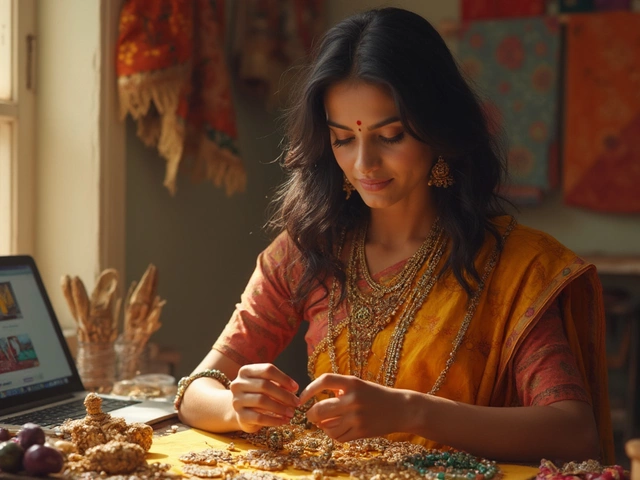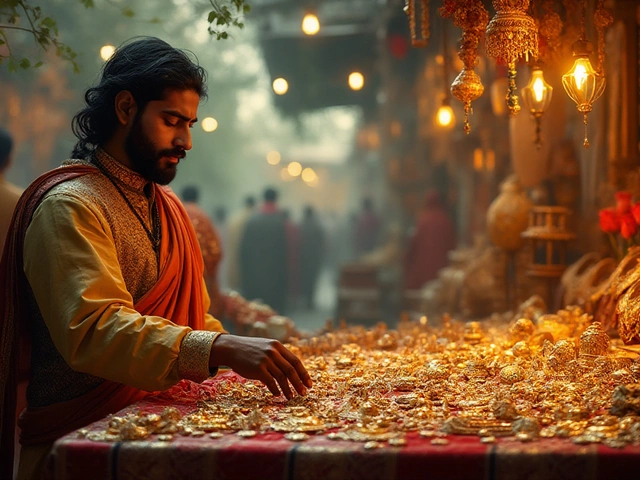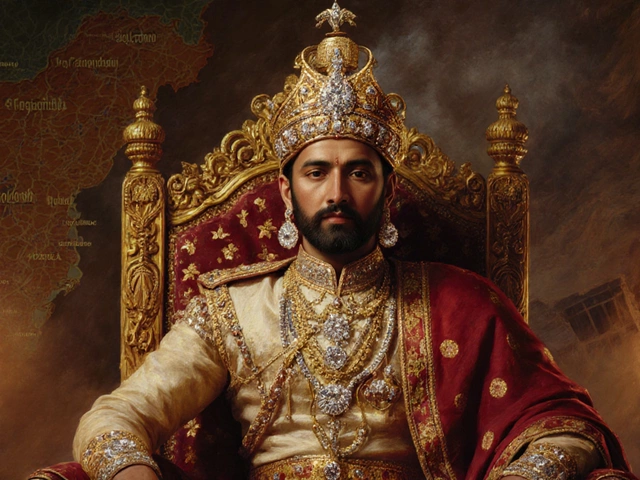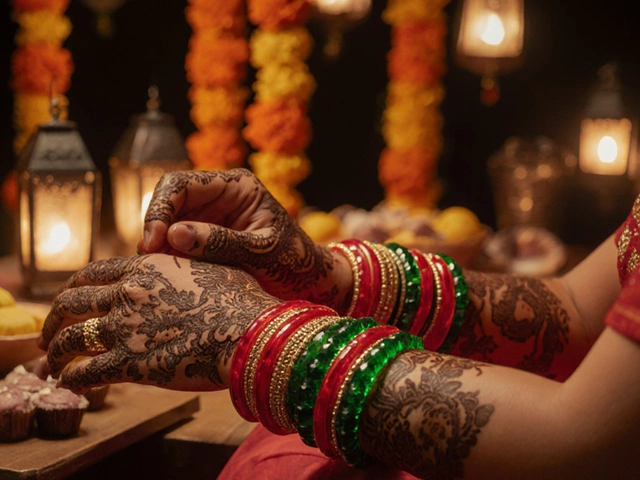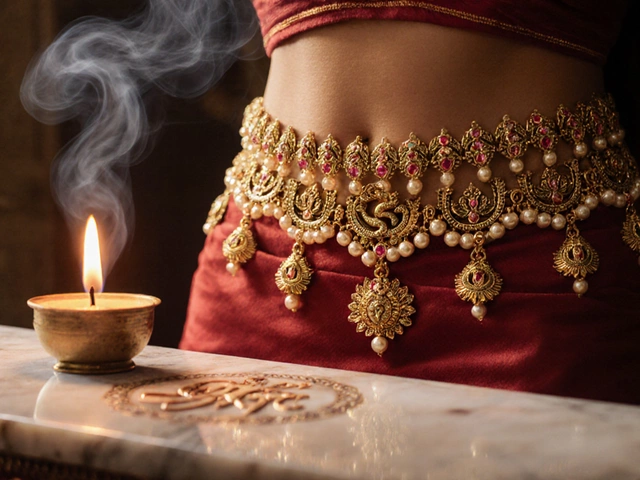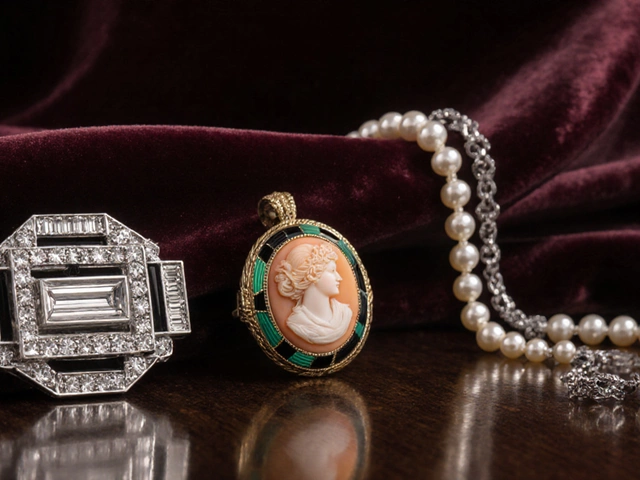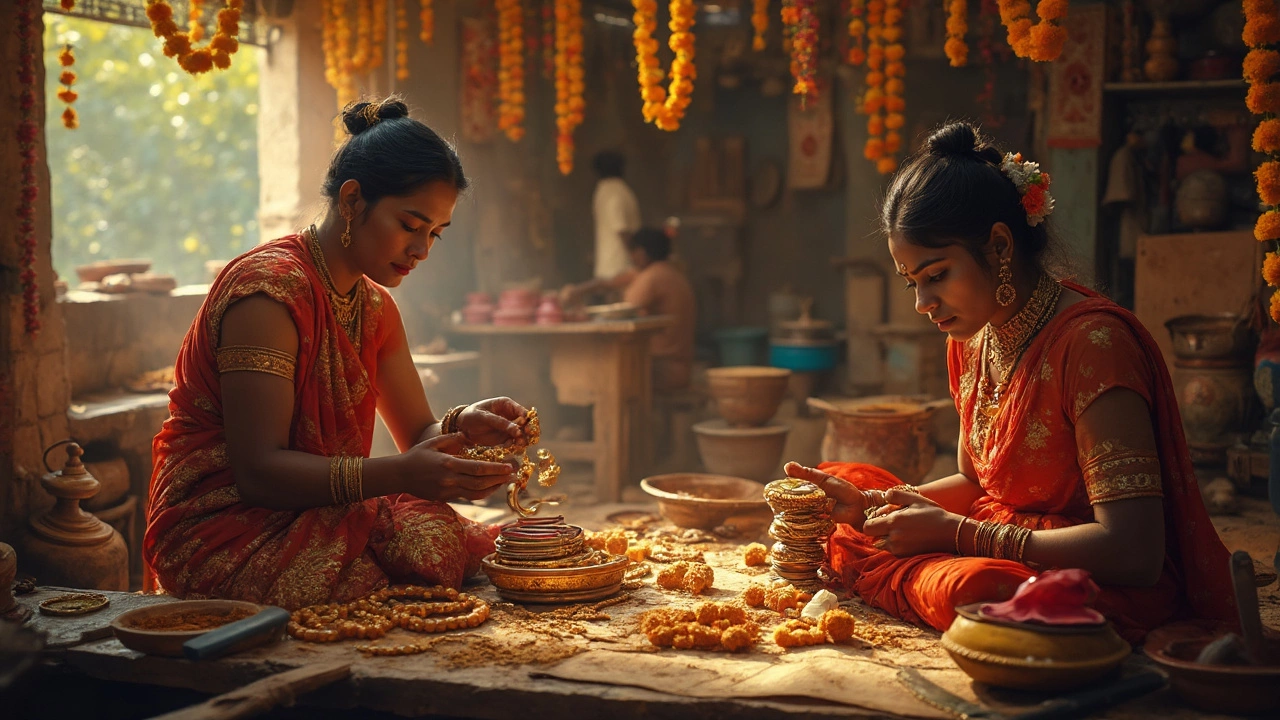
Traditional bangles look simple at first, but their price tags can leave you scratching your head. Why does a set of thin metal circles sometimes cost more than a smartphone? It’s not just about making a profit. There’s a whole world packed into those round little pieces.
Whenever you spot a bangle, think about where it came from. Most high-priced bangles are made with pure gold, sterling silver, glass, or precious stones. The raw material alone can make the price jump—gold doesn’t come cheap, and neither do hand-carved jewels. Even glass bangles, especially the ones from places like Firozabad, involve old-school manufacturing steps that need serious skill.
But material is just the start. Each traditional bangle often passes through many hands—designers, skilled artisans, polishers. When something’s made by a talented person instead of a factory, you pay more. Just like my cat Whiskers can’t be compared to a toy cat, you can’t compare a hand-crafted bangle to a machine-made one from the mall.
- History and Meaning of Bangles in India
- Materials and Their Impact on Cost
- Skilled Craftsmanship: Time and Labor
- Cultural Importance and Market Demand
- Tricks and Trends: How Retailers Set Prices
- Smart Tips for Buying Bangles
History and Meaning of Bangles in India
It’s wild how a simple bangle can tell you so much about India’s history. Archaeologists have dug up bangles from the ruins of Mohenjo-Daro, which goes back over 4,000 years. These weren’t basic plastic ones, either—people were making them out of terracotta, shells, copper, and even gold way back then. Seriously, ancient folks wore bling too.
Wearing traditional bangles in India isn’t just for style points. In many regions, they stand for good luck, health, and even marital status. Married women, especially in North India, almost always wear red glass or gold bangles. In places like Bengal, you’ll see new brides sporting ‘shakha’ (white conch shell) and ‘pola’ (red coral) bangles. These aren’t “just accessories”—they’re loaded with meaning and are always on the shopping list before a wedding.
- In South India, gold bangles are gifted at baby showers. They’re seen as blessings for both the mother and child.
- Punjabi women traditionally wear “chooda,” a set of ivory and red bangles passed down as family heirlooms.
- In Rajasthan and Gujarat, glass bangles are worn in specific numbers and colors during festivals to invite prosperity.
It’s not just about tradition either. Some folks believe that the circular shape of the bangle channels positive energy and good health. That might sound superstitious, but these beliefs help keep the trend alive for generations.
Bangles also tell personal stories. My neighbor, for example, has a set from her grandma’s wedding—over sixty years old. The respect and love tied up with these old-school bangles keep demand high, which, let’s be real, just pumps up the price for authentic ones. This history and meaning are big reasons why bangle price isn’t just about what it's made of, but also what it stands for.
Materials and Their Impact on Cost
The main reason bangles get pricey is because of what they're made from. Let’s break it down. If you look at traditional bangles India is known for, you'll find all sorts of stuff: gold, silver, glass, lac, even plastic or thread. But not all materials hit your wallet the same way.
Gold bangles are top-shelf, no surprise. India’s love affair with gold means these bangles show up at weddings, festivals, and family gatherings. The price swings with the global gold rate—so one month a pair feels doable, next month it’s through the roof. Gold purity also matters: 22-karat gold is the norm for bangles, and the price jumps if you want something purer. Add gemstones or enamel? That adds more to the bill.
Then you have silver. Silver bangles aren’t as expensive as gold but they’re not exactly pocket change, either. The price still depends on the weight and the latest silver rates. Silver’s also prone to price swings, just not as dramatic as gold.
Don’t think glass bangles are always cheap. The plain ones are, but the fancy ones—think hand-painted designs or included gold leaf—can cost a lot thanks to the careful work that goes into them. Some are made using unique old methods, especially in places like Firozabad (famous for glasswork) or Hyderabad for lac bangles. It’s the combination of raw material and how difficult it is to work with that ramps up the price.
| Material | Average Price Range (per bangle) |
|---|---|
| Gold (22K) | INR 8,000 – 40,000+ |
| Silver | INR 500 – 2,500 |
| Glass (Handmade) | INR 50 – 500 |
| Lac | INR 100 – 2,000 |
| Plastic/Thread | INR 10 – 100 |
Here’s a tip: If you’re wondering why the bangle you like costs more than your lunch, check the weight and ask what it’s made of. Add-ons like pearls, diamonds, kundan, or meenakari (enamel work) drive up the price. Plus, if it’s labeled "handmade" or "artisan piece," know you’re paying extra for all those hours spent by skilled hands.
Skilled Craftsmanship: Time and Labor
When it comes to traditional bangles India style, the real price driver is people’s work, not just the metal or stones. Skilled artisans spend years perfecting their craft. In India, families in places like Hyderabad, Jaipur, and Firozabad have often been making bangles for generations. They use their hands and simple tools, not fancy machines, to shape, cut, and decorate each piece.
The process isn’t quick. Some gold bangles take up to 15 hours just to carve detailed patterns. Mirror work, meenakari (enamel painting), or adding tiny gems? That can push production to several days. Mistakes mean wasted gold, so they move slow and steady.
Let’s break down some steps a bangle goes through:
- Design: Coming up with traditional or modern looks, often drawn by hand.
- Material Prep: Melting and shaping gold, silver, or glass into basic rings.
- Decoration: Adding gems, enamel, mirror bits, or hand-painted details.
- Polishing: Smoothing rough edges, then buffing for shine.
- Finishing: Quality check, sometimes with a family member’s stamp of approval.
This kind of work is slow for a reason. Artisans put pride into every detail. They’ll use techniques like wire inlay, filigree, and stone setting—everything is tiny, precise, and unforgiving. If you spot a perfect traditional bangle with no rough joints or glue marks, you’re looking at a pro’s job.
Here’s a little visual to show just how the labor stacks up for artisan-made bangles versus machine-made ones:
| Bangle Type | Average Hours Needed | Number of Craft Steps |
|---|---|---|
| Handmade Gold Bangle | 10-20 | 12-16 |
| Glass Bangle (Handcrafted) | 5-8 | 6-9 |
| Machine-Made Metal Bangle | 1-2 | 3-4 |
See the difference? That’s why artisan labor matters so much in the bangle world. If you want to keep traditional skills alive in India, you’re also paying for that time and expertise—not just the shiny look.
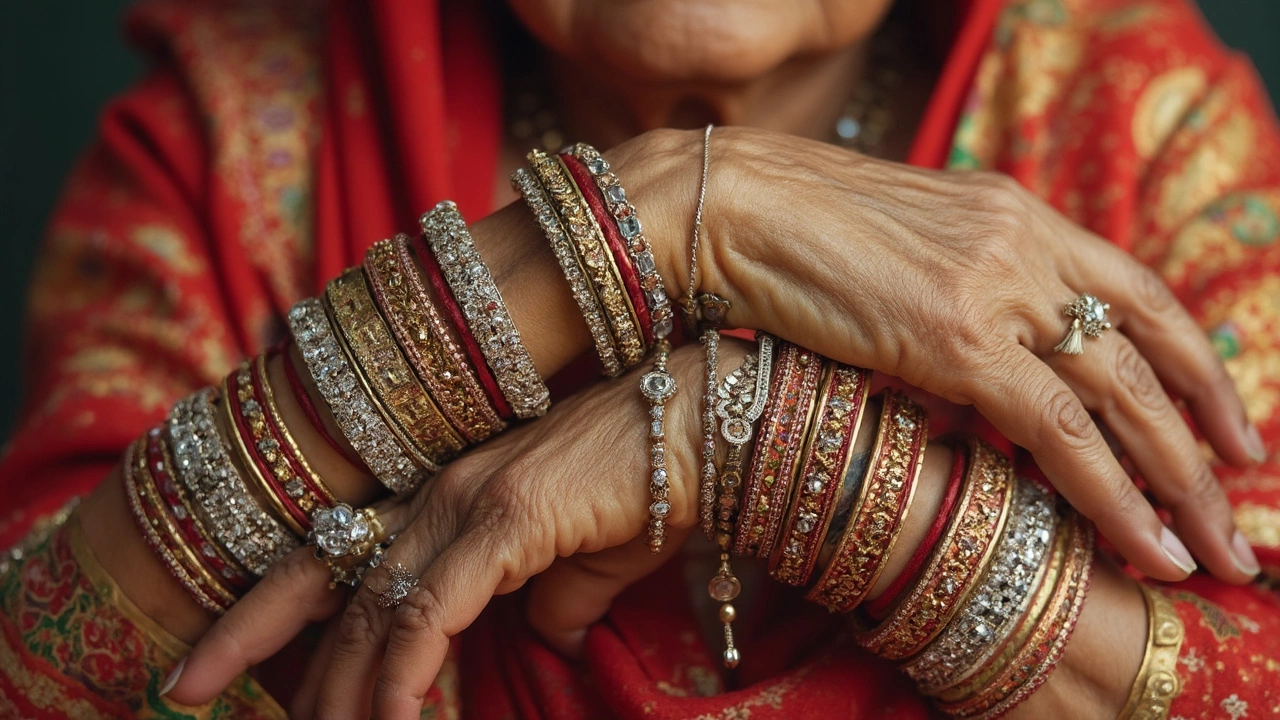
Cultural Importance and Market Demand
Ask anyone in India and they'll tell you: traditional bangles India aren't just accessories. For most women, these bangles carry serious cultural weight. They're a piece of daily life, but also a big deal for weddings, festivals, or religious events. It’s not unusual for families to invest in hefty sets because they’re part of what a bride is expected to bring to her new home. People even believe wearing bangles brings luck and good health, so the demand stays high all year round.
Some families hand down bangle sets for generations. That adds to the value—both sentimental and in rupees. During wedding season, prices can jump as much as 25% simply because everyone is shopping for similar styles. Cities like Hyderabad and Kolkata are famous for entire markets dedicated to bangles, and supply sometimes struggles to keep up with festival demand.
Popular trends also keep things spicy. Bollywood movies can send one new bangle style flying off the shelves. Suddenly, everyone wants that same design, and guess what? Sellers hike the prices. This blend of culture and hype keeps bangle price unpredictable. Here’s a quick look at how demand can shift during a single year:
| Occasion | Change in Bangle Demand |
|---|---|
| Wedding Season | +25% increase |
| Diwali | +15% increase |
| Launch of Trendy Designs | +20% increase |
If you want to save cash, try shopping between big events. If you fall in love with a trending style, you’ll likely pay more, but at least you’ll know exactly why those Indian jewelry prices can get so wild. The cultural pull and constant market shifts together make bangles way pricier than they first look.
Tricks and Trends: How Retailers Set Prices
If you’ve ever wondered why those traditional bangles India shops don’t have obvious price tags, you’re not alone. Retailers play a lot of pricing games and use some sneaky tricks. It starts with raw material price—gold, silver, or even fancy glass. Gold prices, for example, change almost daily. When prices spike, bangle rates go up fast, but when they drop, sellers don’t always pass the savings to buyers so quickly. That’s one way retailers make extra profit.
Trendy designs also bump up prices. Limited edition styles or bangles with Bollywood vibes cost more, simply because people want to own what’s new. Retailers love limited stock signs and the “festive offer” game. During big festivals like Diwali or weddings, demand shoots up, and so do prices.
Another clever trick is bundling. You’ll see sets—packs of 6, 12, or more—costing way more together than if you bought them one by one, especially for bangle price with gold or gems involved. Shops know most people don’t want to break a set, so they charge a premium.
Negotiation is also baked into the system, especially in local markets. First prices are almost always higher than what the shopkeeper will actually accept. If you don’t haggle, you’re paying the “tourist” or “first timer” price. Regulars or those who buy in bulk often get much better deals.
Check out this simple table showing how retailers often set prices in traditional Indian markets:
| Factor | How It Impacts Price |
|---|---|
| Gold/Silver Rate | Bases price per gram; rises with daily metal price fluctuations |
| Design Trend | Limited editions or celebrity styles cost more |
| Craftsmanship | Handmade pieces often priced 20-50% higher |
| Festivals/Season | Peak demand times, prices rise by up to 25% |
| Bargain Room | Negotiated price may drop 10-30% from opening offer |
Big retail chains also use online marketing to convince you that MRP discounts are a big deal, but the "discounted" price is often just the necessary profit margin. So next time you’re shopping for bangles, check different sellers, ask about pricing, and don’t be shy about bargaining. That’s how you get the real bangle price.
Smart Tips for Buying Bangles
Shopping for bangles isn’t just about picking the shiniest pair. There’s real money on the line, so knowing a few tricks can save you from regrets (and help your wallet breathe easier). Check these out before you reach for your next set of traditional bangles India style:
- Know your material: Gold, silver, glass, and modern alloys all have wildly different prices. Pure gold bangles cost the most—at the start of 2025, 22k gold was selling at around ₹6,800 per gram in India. Glass bangles are way cheaper but fragile.
- Check for authenticity: With gold and silver, never trust just the shine. Look for a BIS hallmark on gold or a 925 stamp on silver. These are your best bets to avoid fakes.
- Inspect the work: Handcrafted bangles have tiny details that mass-produced ones don’t. Place bangles side by side. If you spot weird glue marks or uneven edges, it’s probably machine-made or not worth the extra price.
- Focus on fit and comfort: Traditional bangles aren't one-size-fits-all. Measure your bangle size properly—nothing’s worse than splurging on a set and realizing it pinches your wrist. Most Indian stores will help you measure, but at home, use a measuring tape or compare to a bangle you already own.
- Compare prices (seriously): Before buying, check prices in at least two stores or online shops. Even the same bangle price can swing by a few thousand rupees between places, especially in bigger markets like Hyderabad, Jaipur, or Kolkata.
- Ask about the making or wastage charges: Jewelers include this hidden fee in your bill, which sometimes adds up to 10-20% over the metal price. Always ask how much you’re paying just for the work (and negotiate if you can).
- Buy from a trusted retailer: If your aunt raves about a shop in Old Delhi, there’s probably a reason. Reputation matters and established shops rarely mess around with fake stuff.
Here’s a quick look at how different bangles stack up in price ranges:
| Type | Typical Price Range (per bangle) | Durability |
|---|---|---|
| Gold (22k) | ₹10,000 – ₹50,000+ (depends on weight/design) | Very high |
| Silver (925) | ₹1,000 – ₹8,000 | High |
| Glass (Firozabad) | ₹20 – ₹200 | Fragile |
| Metal/Alloy (costume jewelry) | ₹50 – ₹500 | Medium |
Don’t forget to ask about returns or exchange policies, especially for gold or silver. A good jeweler won’t hesitate to buy back or swap pure metal bangles at the latest bangle price, minus small charges. Walk in with a clear budget and a healthy dose of skepticism. You’ll avoid overpaying and actually get bangles worth showing off at your next family get-together.


